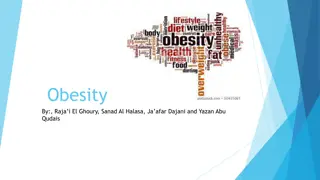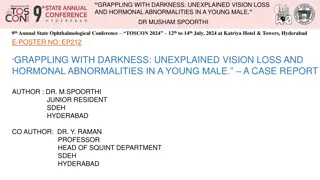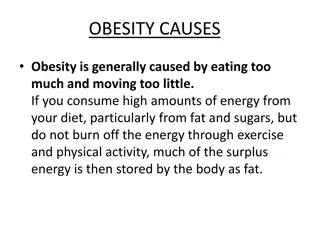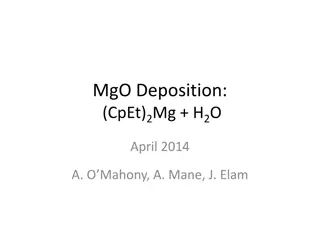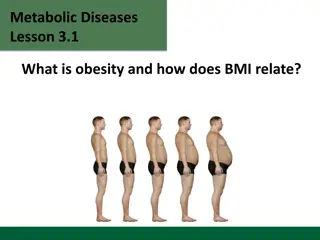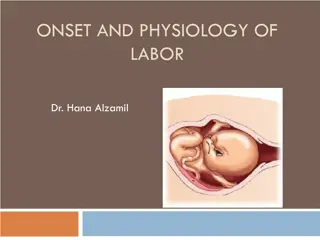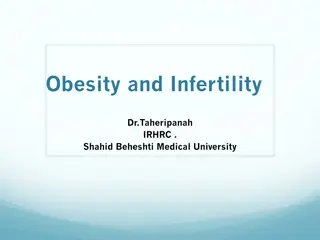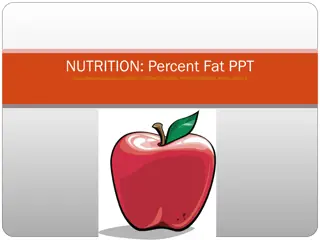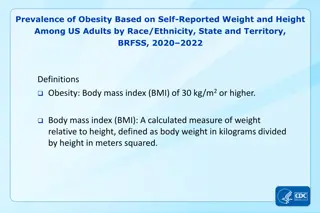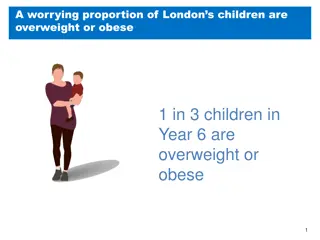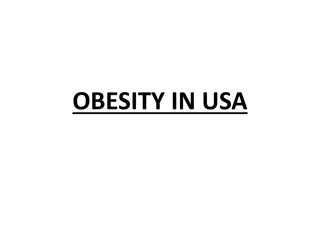Understanding Obesity: Risk Factors, Fat Deposition, and Hormonal Control
Obesity is a condition characterized by excess body fat accumulation, impacting overall health and increasing the risk of various complications such as diabetes, heart disease, and cancer. This content delves into defining obesity based on BMI, exploring anatomic and biochemical differences in fat deposition, discussing the role of adipocytes in fat storage and hormonal regulation, and detailing management and treatment options for obesity.
Download Presentation

Please find below an Image/Link to download the presentation.
The content on the website is provided AS IS for your information and personal use only. It may not be sold, licensed, or shared on other websites without obtaining consent from the author. Download presentation by click this link. If you encounter any issues during the download, it is possible that the publisher has removed the file from their server.
E N D
Presentation Transcript
Obesity Color Index: Main Topic Drs notes Main content Extra info Editing File Important Biochemistry teamwork 438 - Endocrine Block
Objectives: Define and characterize obesity in terms of BMI and risk factors. Compare the anatomic and biochemical differences in fat deposition. Understand the role of adipocytes in fat storage and release of hormones. Discuss the hormonal control of obesity by leptin, adiponectin and other hormones. Discuss the management and treatment options for obesity. Overview: Introduction & Body Mass Index (BMI). Types of fat deposition in the body & Metabolic changes in obesity. Adipocytes (fat cells) and weight gain & Hormones in obesity & Treatment options. 2
Obesity Causes accumulation of excess body fat A disorder of body weight regulatory systems >20% of normal body weight BMI is an indirect measure of obesity BMI GRADE UNDERWEIGHT 18.5 NORMAL 18.5 - 24.9 Body Mass Index Correlates height, weight and amount of body fat in an individual OVERWEIGHT 25.0 - 29.9 OBESE 30.0 - 34.9 I OBESE 35.0 - 39.9 II High BMI is associated with increased mortality risk HIGHLY OBESE 40 III Obesity is associated with a high risk of: High plasma triglycerides Gallstones,arthritis, gout Diabetes mellitus Heart disease Mortality Cancer Hypertension Hypercholesterolemia
Anatomic Differences in Fat Deposition: (Health risks depend on the pattern of fat deposition) Android, apple-shaped , or upper body obesity - excess body fat deposited in the central abdominal area Gynoid, pear-shaped , or lower body obesity - Fat deposited around the hips or gluteal region - Associated risks are lower Associated risk factors are: Hypertension Coronary heart disease Insulin resistance Dyslipidemia Diabetes Different Fat Depots in The Body Biochemical Differences in Fat Deposits Abdominal Fat Gluteal Fat Subcutaneous Fat Visceral Fat Smaller cells Larger cells The fat stored just under the skin in the abdominal and gluteal-femoral region Composed of omental and mesenteric fat More responsive to hormones (both visceral and subcutaneous) Less responsive (subcutaneous) Constitutes 80-90% of the total fat in the body Present in close association with digestive tract Release substances via portal vein to the liver Release substances to circulation with no effect on the liver
Adipocytes Proliferation / differentiation into mature fat cells Pre-adipocytes in adipose tissue Prolonged overnutrition stimulates Increases adipocyte number Triacylglycerols (fats) are deposited in adipocytes (fat cells) which can increase in size up to a limit. Thus obesity is due to a combination of increased fat cell size (hypertrophy) and number(hyperplasia). Fat cells, once gained, are never lost Reduction in weight causes adipocytes to reduce in size but not in number Excessive calories that cannot be stored in adipose tissue spill over into other tissues such as muscle and liver - It is called ectopic fat that is strongly associated with insulin resistance Ectopic fat Factors contributing to obesity Environmental and behavioral Sex: women more susceptible Genetic: familial tendency Drugs: e.g. tricyclic derivatives Activity: lack of physical activity Psychogenic: emotional deprivation/depression Alcohol: problem drinking Smoking: cessation of smoking
Causes of Weight Gain Hypothalamus: control center for hunger and satiety More in and less out = weight gain More out and less in = weight loss Energy imbalance Endocrine disorder: Hormonal imbalance calories consumed not equal to calories used over a long period of time due to a combination of several factors: Social interactions Individual behaviors Environmental factors Genetics Afferent neural signals Hormonal Control Appetite is influenced by: Circulating hormones Metabolites These signals cause the release of hypothalamic peptides and activate efferent neural signals Adipocytes also function as endocrine cells Leptin They release many regulatory molecules: Adiponectin Explanation of the picture: A) - - - - Undernourished state: afferent signals are sent to satiety center in hypothalamus by: Stomach which increase the secretion of Ghrelin to increase the appetite. Pancreas which decreases the secretion of Insulin so there ll be decrease in metabolism. Intestine which decreases the secretion of CCK. Adipocyte which decreases the secretion of Leptin so there ll be decrease in weight-loss. Hypothalamus then send efferent signals to increase appetite & decrease energy expenditure. Overnourished: the opposite happens. Resistin A)
Adipocyte hormones Leptin hormone Adiponectin hormone Leptin causes overweight mice to lose weight and maintain weight loss A protein hormone produced by adipocytes that is required to keep the body weight under control Low levels are seen in metabolic syndrome and diabetes mellitus. A protein hormone exclusively and abundantly secreted from adipocytes 06 01 Leptin secretion: Suppressed in starvation (depletion of fat stores) Enhanced in well-fed state (expansion of fat stores) Adiponectin levels are inversely correlated with body fat percentage and parallels with the HDL level. 05 It promotes the uptake and oxidation of fatty acids and glucose by muscle and liver. 02 04 03 04 Signals the brain about fat store level It net effect is to increase the sensitivity to insulin, and improve glucose tolerance. Regulates the amount of body fat by: Controlling appetite ( ) and energy expenditure ( ) It Blocks the synthesis of fatty acids and gluconeogenesis by hepatocytes. Leptin resistance may have some role in human obesity: - Dieting decreases leptin level - Reducing metabolism, stimulating appetite 6 1 Leptin metabolic rate and appetite in human Leptin Resistance 5 2 Mutation in db gene causes leptin resistance in mice Plasma leptin level in obese humans is usually normal for their fat mass 3 4 The receptor for leptin in the hypothalamus is produced db gene Resistance to leptin has been found in obese humans 1: Obese people have the normal amount of Leptin, but they have a delayed Leptin response, It s helpful to tell the patient to take a small break in the middle of eating a meal to allow leptin secretion. 2: The person either can t produce enough leptin due to genetic abnormality and they become obese, so if you give them leptin they will respond and lose weight OR the receptors are defected, so the person has enough leptin but no usage and this is called leptin resistance . 7
Other Hormones A peptide hormone is secreted by stomach, the secretion increases just before meals and drops after meals. It stimulates appetite & increases food intake & decreases energy expenditure and fat catabolism. Levels in dieters are higher after weight loss: the body steps up ghrelin production in response to weight loss. the higher the weight loss, the higher the ghrelin levels. Ghrelin Cholecystokinin Peptides released from the gut after a meal, sends satiety signals to the brain. Promotes metabolism (& suppresses the appetite immediately). Insulin Metabolic Changes in Obesity Adipocytes send signals that cause abnormal metabolic changes such as: 02 01 03 Dyslipidemia Glucose Intolerance Insulin Resistance
Benefits of Weight Loss in Obesity Treatment Options Slow weight loss is more stable & Weight loss decreases risk factors for obesity leading to: Physical activity combined with healthy diet decreases the level of obesity & reduces risk for CVD and DM. Lower blood pressure. Dieting: use of low-calorie diet & restriction of excessive energy intake Serum triacylglycerols. Drugs: - Blood glucose levels. Orlistat: A pancreatic and gastric lipase inhibitor which decreases the breakdown of dietary fat. Lorcaserin: promotes satiety. mortality. - Energy requirement. Surgery: Surgical procedures are designed to reduce food consumption in patients with BMI >40. It s used when other treatment options fail. HDL levels. Beneficial changes in BMR.
Take Home Messages Obesity is correlated to an increased risk for a number of chronic conditions and mortality Summary Fat deposition (Shape/Anatomical) Hormonal control Android / Apple-shaped Gynoid / Pear-shaped Fat deposited in the central abdominal area, has more risk. Fat deposited around the hips or gluteal region, has less risk. Leptin: decreases appetite, increases energy expenditure, helps in weight loss, it s enhanced in well-fed state. Fat deposition (Type) Subcutaneous Visceral Adiponectin: promotes oxidation and uptake of FA & glucose by muscle & liver, blocks gluconeogenesis & FA synthesis, increases sensitivity to insulin, improves glucose tolerance. Fat stored just under the skin, in abdominal & gluteal regions, constitutes 80-90% of total fat. Fat deposition (Location/Biochemical) Composed of omental and mesenteric fat, has close association with digestive tract. Ghrelin: stimulates appetite, increases food intake, decreases energy expenditure and fat catabolism, it s enhanced in starvation & weight loss. Abdominal Gluteal Smaller cells, more responsive to hormones (both visceral and subcutaneous), release substances via portal vein to liver. Larger cells, less responsive (subcutaneous), release substances to circulation with no effect on the liver. Ectopic fat Cholecystokinin: released after a meal, sends satiety signals to the brain. Insulin: suppresses appetite & promotes metabolism. Excessive calories that cannot be stored in adipose tissue spill over into other tissues (e.g. muscle & liver), it s strongly associated with insulin resistance. 10
Quiz MCQs : SAQs : Q1: Which of the following is CORRECT about Leptin hormone: a) it increases the appetite b) it decreases the energy expenditure c) it s suppressed in starvation d) bd gene mutation cause Leptin resistance Q1: List 3 adipokines secreted by the adipocytes Q2: List 3 metabolic changes that happens is obesity Q2: Which of the following is CORRECT about Adiponectin hormone: a) high level is seen in diabetes b) improves glucose tolerance c) block oxidation of fatty acids d) promote gluconeogenesis Q3: List the difference between subcutaneous fat and visceral fat Q3: Which of the following hormones decrease the energy expenditure: a) CCK b) Insulin c) Leptin d) Ghrelin Q4: List the different anatomical fat deposition and the risks associated with each one Q4: A man s BMI is 36.9 what grade of obese is he according to the measurement a) I b) II c) III d) IIII MCQs Answer key: 1) C 2) B 3) D 4) B 5) A 6) B Q5: Modest weight gain or loss in non obese person effects: a) the size and not the number of adipose tissue b) the number and not the size of adipose tissue c) none of the above SAQs Answer key: 1) Leptin, adiponectin and resistin. Q6: Abdominal fat is: a) large cells b) subcutaneous and visceral c) Subcutaneous only d) no effect on liver 2) Dyslipidemia. Glucose intolerance and Insulin resistance. 3) Slide No.4 4) Slide No.4
Team members What doesn t kill you makes you stronger. - Kelly Clarkson Girls Team: Boys Team: Alkassem Binobaid Fares Aldokhayel Khayyal Alderaan Mashal Abaalkhail Naif Alsolais Omar Alyabis Omar Saeed Rayyan Almousa Yazen Bajeaifer Ajeed Al-Rashoud Alwateen Albalawi Amira AlDakhilallah Deema Almaziad Ghaliah Alnufaei Haifa Alwaily Leena Alnassar Lama Aldakhil Lamiss Alzahrani Nouf Alhumaidhi Noura Alturki Sarah Alkhalife Shahd Alsalamah Taif Alotaibi We hear you Team Leaders Lina Alosaimi Mohannad Alqarni 12





